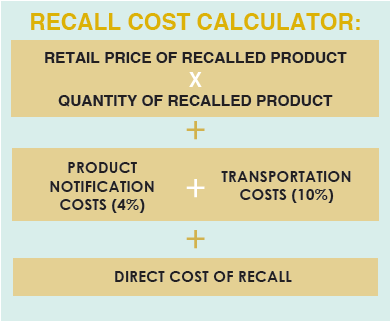Economic Impact of Global Food Safety in our Business: Cost-Benefit of Food Safety Implementation
Weighing the effects of a food safety management system to the business and industry
Text by DR. MANNY GARCIA
A major goal of any food enterprise is to produce wholesome and safe products at the most efficient cost and lowest liability. In the context of farm-to-table food safety systems, allocating the cost-benefit of food safety in economic terms becomes complicated. There are many costs associated with implementing a seamless food safety system along the supply chain from industry to market to consumer concerns. In considering market to consumer practices, the consensus is that food must be safe for the consumer with its delivery and preparation.
IMPACT OF FOODBORNE ILLNESSES ON PUBLIC HEALTH AND CONSUMER CONFIDENCE
The past issues of this magazine discussed the importance of reliable data to support the rationale of food safety regulations and associated programs in lowering costs for the industry. Foodborne disease incidence data in the U.S., Europe, and other developed countries are well-documented and more promptly addressed compared to emerging diseases that may be endemic in developing countries. The United States Food and Drug Administration (US FDA) reported that these regulations are saving the industry approximately $2 billion annually in costs associated with preventable foodborne illnesses. Dairy, meat, fish and shellfish are already subject to strict federal rules. The Centers for Disease Control and Prevention (CDC) found that restaurants are the source of 60 percent of food-borne illness outbreaks. The US FDA’s new farm safety rule targets the norovirus, which caused 46% of the reported illnesses/outbreaks, and is commonly spread to vegetables through fecal-contaminated water.

RATIONALE FOR INVESTING TO ENSURE SAFE FOODS IN THE GLOBAL MARKET
An increase in the globalized food trade with more diversified processes and extensive supply chain in recent years have put greater pressure on food companies to install more vigilant steps to avoid causing food scandals. Indeed, the potential impact of food safety outbreaks on a food business or a company can be devastating.
To address food safety concerns, market forces are driving the implementation of HACCP and prerequisite programs (PRP) throughout the food continuum, particularly the processing sector. When a food-borne illness outbreak occurs, many points in the
food continuum suffer, including the retail sector. Many retailers and grocers have begun to insist that their suppliers have effective food safety systems, including HACCP, implemented in their facilities. This action drives the adoption of HACCP systems by many processors to retain their current market and customer base or, in fact, expand it.
Operational Prerequisite Programs (OPRP) are also increasingly promoted in preventative measures such as HARPC (Hazard Assessment Risk-based Preventive Control).
COSTING FOOD SAFETY PROGRAMS
A food company’s business plan should include food safety considerations, but what will it cost, and what is the return on investment (ROI)? Equating monetary costs directly to food safety requirements may be easier than calculating benefits. In general, direct costs involve the development of food safety controls and preventive measures as well as the associated costs such as training, appraisal and evaluation, monitoring of compliance, and enforcement costs by regulatory and private certifications. These are in addition to in-house expenses on administration, buildings, infrastructure or equipment, documentation, and laboratory tests. The costs of food safety regulations include the cost of production, compliance cost, administrative cost borne by the taxpayers, and the deadweight loss associated with taxation1. Costs of the different food safety and quality activities throughout the food chain can be categorized into:
- Low cost range: labeling, shelf control, qualification of employees, and costs for certification and control
- Medium cost range: traceability, laboratory tests, documentation, animal welfare, environmental protection, and costs for veterinary services
- High cost range: structural investments, transportation, hygienic improvements to facilities, and investments in technical equipment

- Compliance Costs
Hazard Analysis and Critical Control Points (HACCP) systems including Prerequisite Programs (PRPs) and Good Manufacturing Practices (GMPs) represent the important steps to ensure that products meet legal requirements for safety and quality.
Compliance with HACCP means satisfying all regulatory requirements needed to assure that processes are in order to guarantee food safety. If non-compliance occurs, the company is expected to immediately perform corrective action. GMP or PRP guidelines are available for general consumption, it is up to each individual company to decide how such guidelines will be put into effective practice in their own facility.
Implementation of PRPs and HACCP as Key Performance Indicators (KPIs) are important requirements in food safety verification programs. Establishing the cost to satisfy these process KPIs represent an important task for food companies regardless of size and type of product. Importer and private standard certification requirements will also affect costs.
The HACCP component costs of selected medium and large-sized meat and dairy enterprises range from 0.01-0.09% for start-up costs rate and 1.28-2.96% for total annual costs2. The costs of operation for dairy are higher than those for meat operations suggesting that the type of business affects costs.
- Traceability Costs
Traceability is the ability to track any food through all stages of production, processing,
and distribution (including importation and retail). This means that movements can be traced at least one step backward and one step forward at any point in the supply chain3. For food processing businesses, traceability should extend to being able to identify the source of all food inputs such as: raw materials, additives, other ingredients, and packaging. Traceability allows food businesses to quickly identify the product(s) affected by a food safety problem, minimizing disruption to trade and any potential public health risks. Since practices within companies vary so widely, it becomes impossible to generalize traceability costs and benefits. However, for experienced companies, it is clear that good record keeping, which is the foundation for traceability—is beneficial for their business.
- Food Recall – A Constant Threat to Profitability
A food recall occurs when there is reason to believe that a certain food product may cause harm to consumers, and is typically done voluntarily by the manufacturer or distributor. In certain situations, food recalls are requested or mandated by government agencies. Some reasons for recalling food include: (a) discovery of an organism in a product which may make consumers sick, (b) discovery of a foreign material in the product, (c) discovery of a potential allergen in a product, and (d) mislabelling or misbranding of food (e.g. presence of allergen). To many large companies, food recall is the food industry’s biggest threat to profitability.
Food recalls are primarily a public health issue, but it is also a significant economic issue. The economic impact of a recall includes (a) direct costs, which typically include notifications to regulatory bodies, the supply chain and consumers, (b) product retrieval (reverse logistics), (c) storage, (d) destruction, (e) unsaleable products, (f) lost sales, (g) brand damage, and (h) the additional labor costs associated with these activities as well as the investigation of the root cause. They do not include what could possibly be the higher expense to the company from litigation costs and the impact to the company’s market value and brand reputation. While there is limited information on the true costs of recall to the food industry, it is important to gain an understanding of the direct financial impact on the company.
Based on the model developed by Resende Filho and Burr4, the approximation formula to calculating these costs are as follows:

SUMMARY POINTS OF THE COST-BENEFIT IN A FOOD SAFETY SYSTEM
Food safety delivery systems are expected to increase the cost of production and distribution and will likely be passed on to consumers. In contrast, as food safety becomes commonplace in the food supply chain, the overall effect will help reduce product recall, increase the confidence in their brand, and ultimately, lessen the health cost to the consuming public.
The cost of implementing a food safety program varies based on company size and segment of the industry. Economic analysis of food safety related costs showed that it is much cheaper for a producer to invest in preventing the occurrence of foodborne outbreaks than the cost of rectifying its after-effects.
Many processors and small enterprises struggle with food safety program implementation and are daunted by start-up costs. Implementation of food safety systems must be considered as part of the long-term cost of participating responsibly in the food industry and is key to long-term viability of companies.
Finally, while everyone wants to do the right thing for food safety, companies must realize that it’s better to invest in prevention as opposed to response.
- Antle, J.M. 1999. Benefits and costs of food safety regulation. Food Policy 24(6):605-623 ·
- Stephanie Krieger and Gerhard Schiefer and Carlos A. da Silva. 2006. Costs and benefits in food quality systems: concepts and a multi-criteria evaluation approach by http://www.fao.org
- Jennifer McEntire . 2014. Traceability: Costs, Benefits, and the Future. www.foodqualityandsafety. com/article/traceability-costs-benefits
- Recall: The Food Industry’s Biggest Threat to Profitability. 2010. Economic Research Service/USDA International Trade and Food Safety/AER-828:1-25. Food Defense Whitepaper Series: Part Two
- Romano, D., A. Cavicchi, B. Rocchi, and G. Stefani. 2004. “Costs and Benefits of Compliance for HACCP Regulation in the Italian Meat and Dairy Sector.” 84th EAAE Seminar, Zeist, The Netherlands, February 2004.
- Risk Communication on Food Recalls
The influence of heightened 24/7 media coverage and the power of social networking on consumer choices for specific products can be compelling. In the year following the large spinach and peanut recalls in the U.S., almost three-quarters of consumers stopped purchasing such products out of safety concerns, dropping to one-quarter in the second year. In a Harris Interactive poll, consumers indicated that 55% would switch brands temporarily following a recall, 15% said they would never purchase the recalled product, and 21% would avoid purchasing any brand made by the manufacturer of the recalled product.
IMPACT OF FOOD SAFETY COSTS TO EXPORTERS AND SMES
The Foreign Suppliers Verification Program (FSVP) of FSMA requires U.S. importers and foreign suppliers to ensure that their products, ingredients or fresh produce entering the country are “pathogen-free”. FSVP and similar regulations in advanced countries impose further burdens to exporters from developing countries with less access to information on the risks associated with their food products. The additional demand for global food standards certifications (e.g. FSSC 22000, BRC, and SQF) from importers further aggravates these economic concerns. The lack of understanding and funds to implement food safety systems can discourage many to enter into a risky food business venture.
It is no surprise that many entrepreneurs of small businesses, while showing genuine interest on promoting food safety issues, express trepidation and misgivings on the cost of implementing GMP-HACCP. To reduce these initial certification costs, many start-up and small companies with serious intention to export resort to toll manufacturing or contract manufacturing as alternatives while building their brand image as they upgrade their own food safety and quality systems. Small companies may experience the most financial burden associated with implementing HACCP and other programs but the benefits related to reduced incidence of foodborne illness or rejection by an importing country due to non-compliance will outweigh the costs for most businesses.
BENEFITS OF FOOD SAFETY PROGRAMS
The assessment of benefits of complying with food safety standards can be carried out in a qualitative way. Much more difficult is the monetary assessment of benefits from the marketing and/or efficiency improvement (Romano et al., 2004).
- Common Benefits of HACCP
There is agreement from different studies that with the implementation of HACCP, the following economic benefits can be realized:
- Increased Buyer and Consumer Confidence. Food processors with implemented HACCP systems provide buyers and consumers the assurance and confidence that the facility is producing a safe food product.
- Maintaining or Increasing Market Access. In many cases, buyers require HACCP to maintain market share and/ or gain access to previously inaccessible markets. HACCP may also permit re-entry into a market that had been lost.
- Business Liability Protection. A HACCP system can provide a facility with increased business liability protection and may lead to reduced insurance premiums.
- Reduced Operational Costs. Verification of HACCP systems often reveals areas where operational costs can be streamlined. Savings from reduced failure costs (of outputs that do not meet the required standards) are realized.
- Efficient Oversight. Proper HACCP implementation can provide a company with ongoing efficient and cost effective implementation steps through regular process review of CCP, monitoring and record keeping.
- Improved Product Quality and Consistency. In addition to controlling the microbial hazards, growth of spoilage microorganisms is also minimized leading to an increased product shelf life and improve product consistency.
- Reduced Wastage. With the regular monitoring inherent in the preventative nature of HACCP system, rework or rejection is minimized, problems can be anticipated earlier, and costs of wastage are reduced.
A social impact and indirect economic benefit is the increased awareness among company employees on their roles in the production of a safe product as an integral part of developing a food safety culture.
- Benefits from Traceability
New research suggests that perfect traceability could affect the direct costs of a recall by up to 90% for products with a 14-day shelf life. On the other hand, the savings can reach 95% for products with a 28-day shelf life. It can be an effective solution to mitigate risk when a recall occurs. Since majority of recalls happen due to operational mistakes, a commitment and adherence to meeting one of the highest global food safety standards recognized by the Global Food Safety Initiative (GFSI) can be the best defense against food recalls3. The conclusion is that manufacturers of shelf stable goods have the most to gain by investing in traceability.

For interested subscribers or advertisers of Food Safety Trends Philippines Magazine, click here or send us an email at [email protected].


